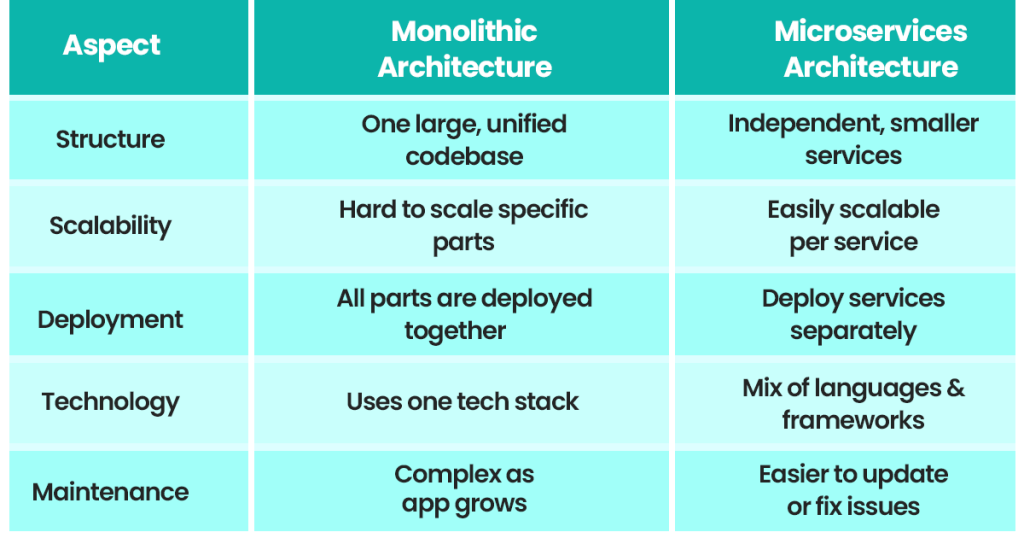
Our Blog Details
Home / Our Blog DetailsHave you ever wondered how big companies like Netflix, Amazon, or Uber manage to run massive web apps so smoothly — even with millions of users online at once? The secret behind their speed, scalability, and reliability lies in one powerful concept — Microservices Architecture.
In today’s world of fast-changing technology, businesses need to build and update web applications quickly without breaking existing systems. That’s where microservices have become a game-changer for modern web development.
Let’s break down what microservices are, how they work, and why they’re shaping the future of web development — in the simplest way possible.
What Are Microservices?
In simple words, microservices are small, independent parts of a big web application that work together like a team. Imagine your web app as a restaurant. Instead of one chef doing everything — cooking, serving, billing — you have specialists:
- One cooks the meals
- One handles payments
- One manages deliveries
Each one does their own job efficiently — yet they all work together to serve customers. That’s how microservices work. Each microservice is responsible for one specific function — for example:
- Authentication (login/signup)
- Payment processing
- Product catalog
- Notifications
- Search
They run independently, communicate through APIs, and can be built using different programming languages or frameworks. This approach makes your app modular, flexible, and easier to scale which is why it’s now the backbone of most modern web development.
Microservices vs. Monolithic Architecture
Before microservices, most apps were built using a monolithic architecture — meaning everything (frontend, backend, database, etc.) was bundled together in one big codebase.
Let’s quickly compare both:

In a monolithic setup, even a small update — like fixing a login bug — could require redeploying the entire system. But with microservices, you can update just one small part without affecting the rest of the app. That’s a huge advantage for developers and businesses aiming for agility.
How Microservices Power Modern Web Development
So, why is everyone moving toward microservices? Because they solve many challenges that developers face with traditional architectures. Let’s see how they make web development smarter, faster, and more efficient:
1. Scalability Made Easy
With microservices, you can scale only the parts of your application that need it. For example, if your “payment” service gets heavy traffic during sales, you can scale that part alone — without touching the entire app. This saves both time and server costs.
2. Faster Development and Updates
Different teams can work on different services at the same time. Your backend team can improve the “user” service while another team updates the “cart” system — no conflicts, no delays.
3. Continuous Deployment Without Downtime
You can release updates or new features anytime — without taking the app offline. This is why apps like Netflix rarely face downtime during updates.
4. Flexibility in Technology
Each service can use the best technology for its task. For instance, one microservice may run on Node.js, another on Python — and they’ll still communicate smoothly using APIs.
5. Improved Fault Isolation
If one microservice fails, it doesn’t bring down the whole system. That means your app stays running even if one part crashes — ensuring a smooth user experience.
Moreover, to understand how web development drives business growth, explore our detailed post on the Benefits of Web Development in a Business
Core Components of a Microservices Architecture
Building microservices isn’t just about dividing features, it’s about connecting them efficiently. Here are the key components that make it all work:
1. API Gateway
Acts as the main entry point for users. It receives user requests and directs them to the correct microservice. Think of it as a receptionist that routes every query to the right department.
2. Service Discovery
Helps identify and locate microservices dynamically, especially in cloud environments where services might change locations frequently.
3. Load Balancer
Distributes incoming traffic evenly so no single service gets overloaded. This ensures fast and stable performance even during peak hours.
4. Database per Service
Unlike monolithic apps where everything shares one big database, in microservices — each service has its own database. This keeps things independent and avoids data conflicts.
5. Containerization & Orchestration
Tools like Docker and Kubernetes play a huge role in running and managing microservices.
Docker packages each microservice with its environment, and Kubernetes helps deploy, scale, and monitor them seamlessly.
If you’re also curious how streamlining development and operations boosts speed and quality, explore our article titled Why DevOps is the Key to Agile Software Development
Benefits of Microservices for Developers and Businesses
Microservices offer more than just speed — they change how teams build, scale, and maintain web applications.
1. Better Scalability and Flexibility
Businesses can grow without worrying about performance issues. Whether it’s 1,000 or 1 million users — you can scale on demand.
2. Easier Maintenance
Small services mean smaller, cleaner codebases. This makes debugging and updating much easier.
3. Faster Time-to-Market
Developers can release new features quickly, helping businesses stay competitive and adapt to customer needs faster.
4. Enhanced Fault Tolerance
Even if one microservice fails, the rest of the application keeps working. This ensures a reliable experience for users — a key factor for modern businesses.
5. Cost Efficiency
You only scale what you need. This efficient use of resources makes microservices cost-effective, especially in cloud-based environments.
Planning your web development budget? Get detailed insights in our article titled Cost to Build a Website.
Challenges of Implementing Microservices
Of course, microservices aren’t magic. They come with their own set of challenges that developers need to plan for.
1. Complexity in Communication
Since services are distributed, they must communicate through APIs — which can add complexity and latency if not handled properly.
2. Data Consistency Issues
Each service manages its own database, so keeping data consistent across services can be tricky.
3. Difficult Monitoring
Tracking performance and debugging across multiple services is harder than managing one big app. That’s why observability tools like Prometheus, Grafana, or ELK Stack are often used.
4. Requires Strong DevOps Setup
To fully benefit from microservices, you need automated CI/CD pipelines for smooth deployment and updates.
5. The “Distributed Monolith” Problem
Without proper design, microservices can become overly dependent on each other — defeating their purpose of independence. Proper architecture planning is key.
Best Practices for Adopting Microservices
If you’re considering switching to microservices, here are some tried-and-tested practices to keep in mind:
- Start Small
Don’t break your entire system overnight. Begin by converting one feature into a microservice — like authentication or billing — and test how it performs.
- Use Containerization
Docker ensures your microservices run consistently across different environments (development, testing, production).
- Automate Everything
From testing to deployment — automation reduces errors and speeds up the process.
- Implement API Gateways
They simplify communication between services and enhance security.
- Focus on Monitoring
Use monitoring tools to track service performance and detect issues early.
- Maintain Clear Documentation
Since multiple teams work on different services, documentation helps avoid confusion and ensures smooth collaboration.
Real-World Examples of Microservices in Action
Let’s look at how some of the biggest names in tech are leveraging microservices to stay ahead:
Netflix
Netflix is one of the pioneers of microservices. They use it to handle millions of user requests per second — from streaming and recommendations to billing and user data — all managed by independent microservices.
Amazon
Amazon’s platform runs on hundreds of microservices. Each department (like search, payments, product management, checkout) works independently — allowing fast updates without system-wide issues.
Uber
Uber relies on microservices for its global operations. From trip matching to driver management, payments, and location tracking — each function runs as a separate service, ensuring scalability and resilience.
The Future of Microservices in Web Development
Microservices are not just a trend — they’re the foundation of the next generation of web apps.
Here’s what’s coming next:
- Serverless Microservices: Developers can build and run services without managing servers.
- AI Integration: Smart monitoring and optimization of microservice systems using machine learning.
- Edge Computing: Running services closer to users for faster response times.
- Cloud-Native Development: Microservices perfectly fit into the cloud ecosystem, allowing apps to run seamlessly on platforms like AWS, Azure, or Google Cloud.
As web apps become more complex, the need for scalable, modular, and flexible systems will keep pushing microservices forward.
Why Choose ITclan BD for Modern Web Development
At ITclan BD, we specialize in building modern, scalable, and high-performing web applications powered by the latest technologies — including microservices architecture. Whether you’re launching a startup platform or upgrading an existing system, our expert developers design solutions that are fast, secure, and future-ready.
We focus on clean code, seamless user experience, and smart integration — so your business runs smoother and grows faster. If you’re ready to take your web app to the next level, ITclan BD is your trusted partner for building robust, scalable, and innovative digital solutions that stand out.
Conclusion
Microservices have completely transformed how modern web applications are built and maintained. They make apps faster, more reliable, and easier to scale, giving businesses a powerful edge in the digital world.
If your goal is to build a web application that grows with your business — microservices are the way to go. By breaking big problems into smaller, manageable parts, you can innovate faster, deploy smoother, and deliver better user experiences — all without worrying about downtime or performance issues.
In short — microservices aren’t just the future of web development; they’re already the present.
Frequently Asked Questions
Yes! Microservices allow developers to optimize and scale each service individually. This targeted scalability reduces server load, improves app performance, and ensures a smooth user experience even during traffic spikes.
Absolutely. Microservices let startups begin with a few essential features and add new services as the business grows. It’s a flexible, future-ready approach that prevents bottlenecks and allows gradual scaling without huge upfront infrastructure costs.
Each microservice can be scaled independently, meaning only the services under heavy load get extra resources. For example, during a sale, the checkout or payment service can scale without affecting the rest of the application. This makes scaling efficient and cost-effective.
Common technologies include Docker, Kubernetes, Node.js, Spring Boot, Python, Go, and API Gateways. These tools help developers build, deploy, and manage microservices efficiently in modern web development.
Yes! Many businesses start by converting one core feature (like authentication or orders) into a microservice. Over time, they gradually migrate other modules. This step-by-step migration reduces risk while taking advantage of microservices benefits.
Recent Blog Post
Quality Is Our Strength

Voice Search Optimization: The Next Frontier in SEO...
Have you ever asked Google Assistant to “find the best restaurant near me”? Or did you tell Siri to “play relaxing music”?If yes, then you’ve already used voice search, which is o...

How Cloud-Based DevOps Solutions Are Transforming IT Operati...
The technology is upgrading fast, as well as, businesses can’t afford to wait weeks or months for software updates. Customers expect smooth experiences, fast features, and quick fixes whe...

The Benefits of Continuous Integration and Continuous Deploy...
Right now, software development is no longer about releasing updates once in a blue moon. Users expect frequent updates, faster features, and bug-free experiences. This is where Continuous ...

